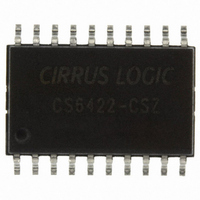CS6422-CSZ Cirrus Logic Inc, CS6422-CSZ Datasheet - Page 12

CS6422-CSZ
Manufacturer Part Number
CS6422-CSZ
Description
IC SPEAKERPHONE ENHANCED 20SOIC
Manufacturer
Cirrus Logic Inc
Type
Audio Processorr
Datasheet
1.CS6422-CSZ.pdf
(48 pages)
Specifications of CS6422-CSZ
Package / Case
20-SOIC
Applications
Speakerphones
Mounting Type
Surface Mount
Product
General Purpose Audio Amplifiers
Available Set Gain
34 dB
Thd Plus Noise
0.03 %
Operating Supply Voltage
5 V
Supply Current
10 mA, 50 mA
Maximum Operating Temperature
+ 70 C
Mounting Style
SMD/SMT
Audio - Load Impedance
10 KOhms
Input Offset Voltage
2.12 V
Minimum Operating Temperature
0 C
Supply Voltage (max)
5.5 V
Supply Voltage (min)
4.5 V
Rohs Compliant
Yes
Operating Temperature Range
0°C To +70°C
Digital Ic Case Style
SOIC
No. Of Pins
20
Lead Free Status / RoHS Status
Lead free / RoHS Compliant
Lead Free Status / RoHS Status
Lead free / RoHS Compliant, Lead free / RoHS Compliant
Other names
598-1200-5
Available stocks
Company
Part Number
Manufacturer
Quantity
Price
Company:
Part Number:
CS6422-CSZ
Manufacturer:
CIRRUS
Quantity:
61
Company:
Part Number:
CS6422-CSZ
Manufacturer:
CIRRUS
Quantity:
4
Part Number:
CS6422-CSZ
Manufacturer:
CIRRUS
Quantity:
20 000
Company:
Part Number:
CS6422-CSZR
Manufacturer:
CREE
Quantity:
210
through the Microcontroller Interface. This gain
stage allows gains of 0 dB, 6 dB, 9.5 dB, and 12 dB
to be added prior to the ADC input. The default
gain stage setting is 0 dB.
The signal at APO should not exceed 2.5 V
0 dB gain stage setting. If a different gain setting is
used, then the full-scale signal at APO must also
change. Table 1 shows full-scale voltages as mea-
sured at APO for the given programmable gain:
MB serves to provide decoupling for the internal
voltage reference, and must have a 0.1 µF and a
10 µF capacitor to ground for bypass. Noise on MB
will strongly influence the overall analog perfor-
mance of the CS6422.
The acoustic output, AO, should connect to a sin-
gle-pole low-pass RC network with a corner fre-
quency of 4 kHz, which will filter out-of-band
components. The full-scale voltage swing at AO is
3.1 V
driving a load of 10 kΩ or more.
3.1.2
The pins NI (pin 17) and NO (pin 4) form the Net-
work Interface. The details of the Network Inter-
face are shown in Figure 6.
NI is the input from the telephone network into the
CS6422. The signal into NI must be low pass fil-
tered by a single-pole RC filter with a corner fre-
quency of 8 kHz.
RGain, a programmable analog gain stage accessi-
ble through the Microcontroller Interface, ampli-
fies signals received at NI. This gain stage allows a
gain of 0 dB, 6 dB, 9.5 dB, or 12 dB to be added
12
12
Table 1. Full scale voltages for each gain stage
pp
Gain Setting
maximum, 1 V
Network Interface
9.5 dB
12 dB
0 dB
6 dB
rms
typical. AO is capable of
Full-scale Voltage
1.25 V
0.84 V
0.63 V
2.5 V
pp
pp
pp
pp
pp
at the
prior to the ADC input. The default gain stage set-
ting for the network side is 0 dB.
The signal at NI should not exceed 2.5 V
0 dB gain stage setting. If another gain setting is se-
lected, then the full-scale signal at NI will change.
Table 1 shows full-scale voltages as measured at NI
for the given programmable gain.
The output to the telephone network side, NO,
should connect to a single pole RC network with a
corner frequency at 4 kHz, which will filter out-of-
band components. The maximum swing NO is ca-
pable of producing is 3.1 V
typical. NO is capable of driving a load of 10 kΩ or
more.
3.2
The registers and control functions of the CS6422
are accessible through the Microcontroller Inter-
face, which consists of three pins: DATA (pin 8),
STROBE (pin 7), and DRDY (pin 6). These inputs
can connect to the outputs of a microcontroller to
allow write-only access to the 16-bit Microcontrol-
ler Control Register (MCR).
3.2.1
The Microcontroller Interface is implemented by a
serial shift register that is clocked by STROBE and
gated by DRDY. The microcontroller begins the
transaction by setting DRDY low while STROBE
is low. The most significant bit (MSB), Bit 15, of
the 16-bit data word should be presented to the
DATA pin and then STROBE should be brought
high to shift the data bit into the CS6422. STROBE
should be brought low again so it is ready to shift
the next bit into the shift register. The next data bit
should then be presented to the DATA pin ready to
be latched by the rising edge of STROBE. This pro-
cedure repeats for all sixteen bits as shown in Fig-
ure 7. After the last bit (Bit 0) has been shifted in,
DRDY should be brought high to indicate the con-
clusion of the transfer, and four or more extra
Microcontroller Interface
Description
pp
maximum, 1 V
CS6422
CS6422
DS295F1
pp
at the
rms

















